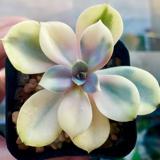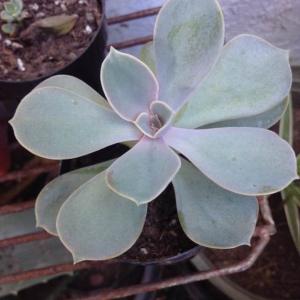文章
Dummer. ゛☀
2017年10月02日

Scientific Name
Echeveria agavoides Lem.
Common Names
Molded Wax, Molded Wax Agave, Carpet Echeveria
Synonyms
Cotyledon agavoides, Echeveria obscura, Echeveria yuccoides, Urbinia agavoides, Urbinia obscura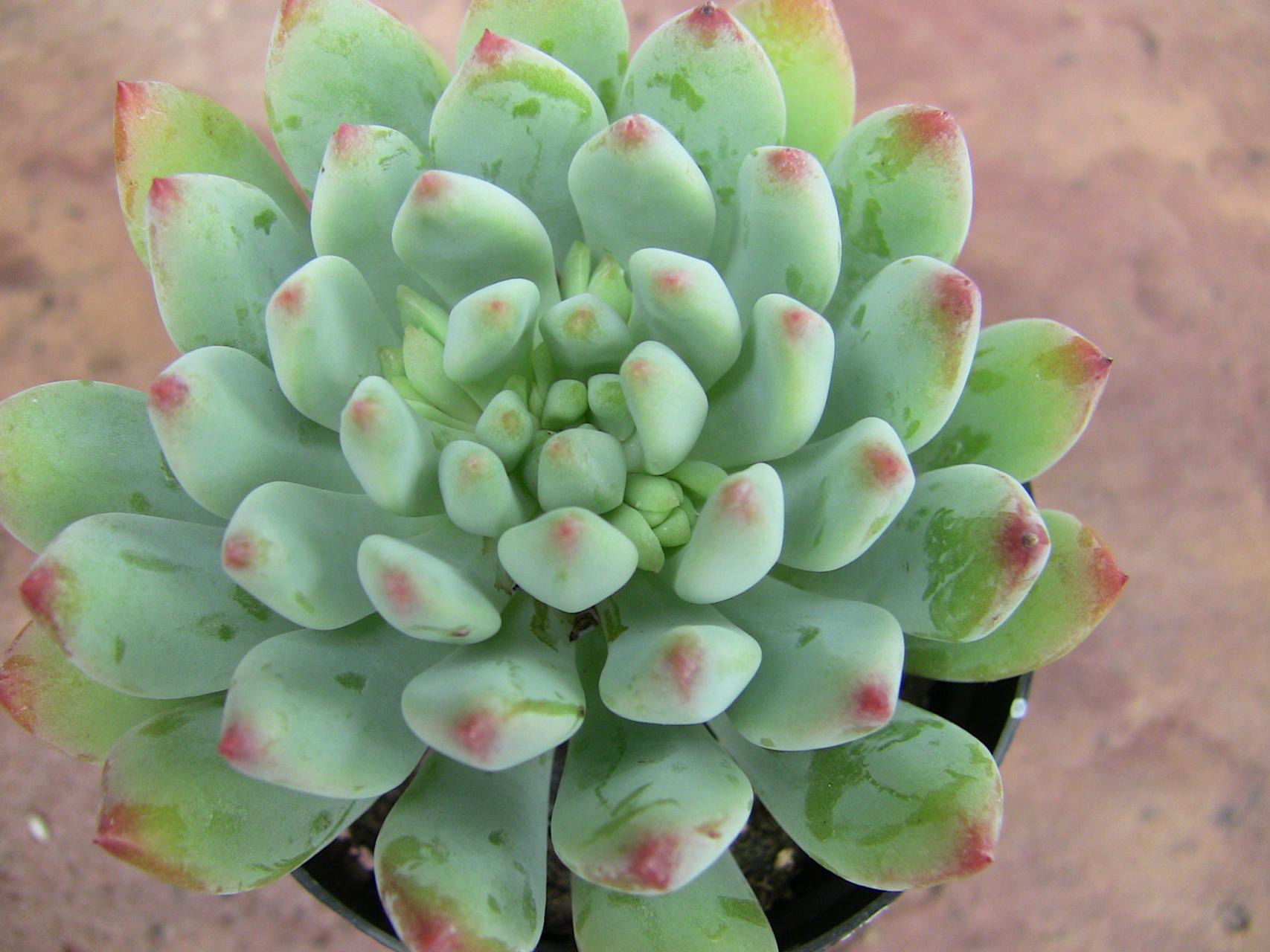
Scientific Classification
Family: Crassulaceae
Subfamily: Sedoideae
Tribe: Sedeae
Subtribe: Sedinae
Genus: Echeveria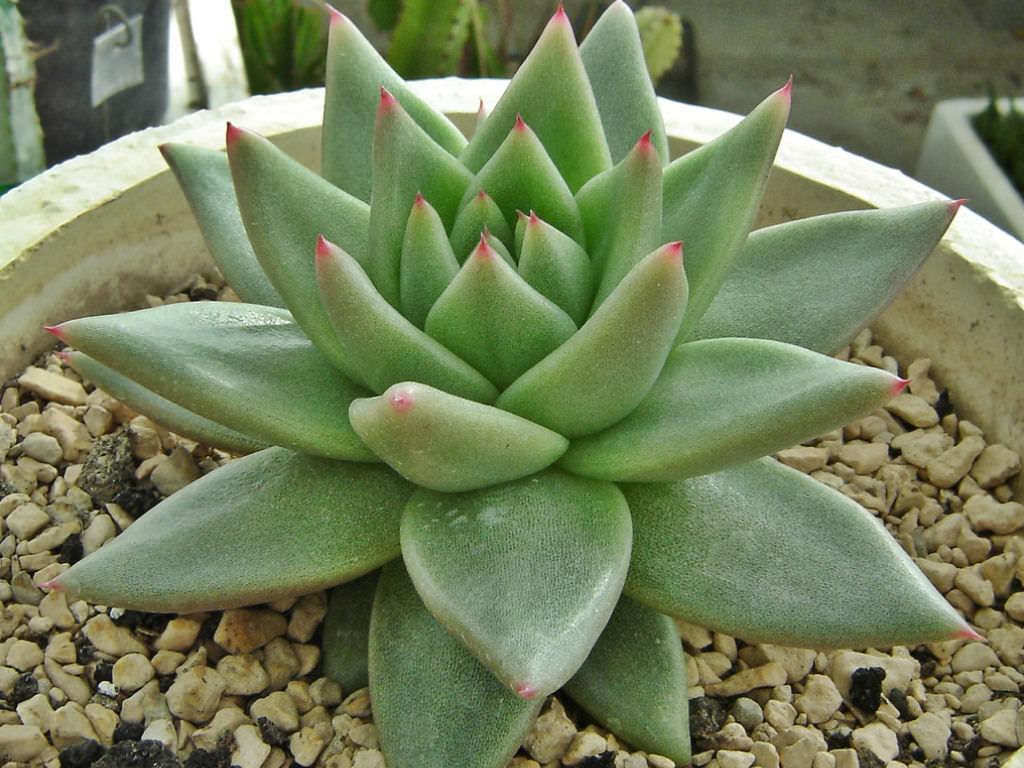
Description
Echeveria agavoides is a small, stemless, succulent plant, up to 5 inches (12.5 cm) tall, with a star-shaped rosette of fat leaves up to 8 inches (20 cm) in diameter. The apple-green leaves are triangular, with reddish edges and a terminal spine. The inflorescences in summer appear on slender, single-sided cymes up to 20 inches (50 cm) long. The flowers are pinkish-red with petals tipped with dark yellow.
How to Grow and Care
Most of the common Echeveria species are not complicated succulents to grow, provided you follow a few basic rules. First, be careful never to let water sit in the rosette as it can cause rot or fungal diseases that will kill the plant. Additionally, remove dead leaves from the bottom of the plant as it grows. These dead leaves provide a haven for pests, and Echeveria are susceptible to mealy bugs. As with all succulents, careful watering habits and plenty of light will help ensure success.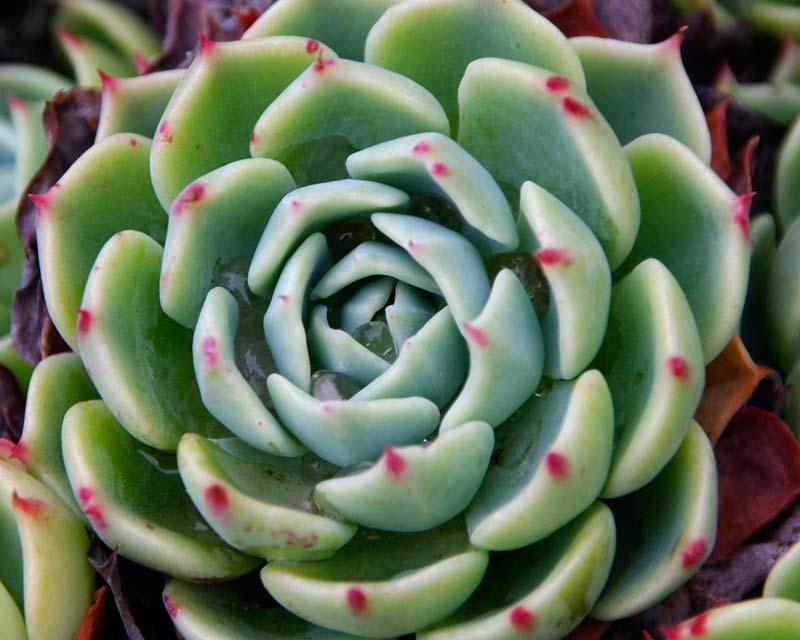
Most Echeveria can be easily propagated from leaf cuttings, although a few are better from seeds or stem cuttings. To propagate a leaf cutting, place the individual leaf in a succulent or cacti mix and cover the dish until the new plant sprouts. Repot as needed, preferably during the warm season.
Echeveria agavoides Lem.
Common Names
Molded Wax, Molded Wax Agave, Carpet Echeveria
Synonyms
Cotyledon agavoides, Echeveria obscura, Echeveria yuccoides, Urbinia agavoides, Urbinia obscura

Scientific Classification
Family: Crassulaceae
Subfamily: Sedoideae
Tribe: Sedeae
Subtribe: Sedinae
Genus: Echeveria

Description
Echeveria agavoides is a small, stemless, succulent plant, up to 5 inches (12.5 cm) tall, with a star-shaped rosette of fat leaves up to 8 inches (20 cm) in diameter. The apple-green leaves are triangular, with reddish edges and a terminal spine. The inflorescences in summer appear on slender, single-sided cymes up to 20 inches (50 cm) long. The flowers are pinkish-red with petals tipped with dark yellow.

How to Grow and Care
Most of the common Echeveria species are not complicated succulents to grow, provided you follow a few basic rules. First, be careful never to let water sit in the rosette as it can cause rot or fungal diseases that will kill the plant. Additionally, remove dead leaves from the bottom of the plant as it grows. These dead leaves provide a haven for pests, and Echeveria are susceptible to mealy bugs. As with all succulents, careful watering habits and plenty of light will help ensure success.

Most Echeveria can be easily propagated from leaf cuttings, although a few are better from seeds or stem cuttings. To propagate a leaf cutting, place the individual leaf in a succulent or cacti mix and cover the dish until the new plant sprouts. Repot as needed, preferably during the warm season.
3
6
文章
Dummer. ゛☀
2017年10月02日

Scientific Name
Dudleya virens (Rose) Moran
Common Names
Green Liveforever, Bright Green Dudleya
Synonyms
Cotyledon virens, Echeveria virens
Scientific Classification
Family: Crassulaceae
Subfamily: Sedoideae
Tribe: Sedeae
Subtribe: Sedinae
Genus: Dudleya
Description
Dudleya virens is an uncommon species of perennial, succulent plant. The leaves are fleshy and strap-shaped, up to 8 inches (20 cm) long and up to 1.2 inches (3 cm) broad, tapering from the base (or from near middle) and are mostly green. They are arranged in a rosette. The flowers are white, with five petals up to 0.4 inch (1 cm) long. Flowers are produced in April, May, and June.
How to Grow and Care
Most of the myriad habitats Dudleyas occupy become dry in summer. Therefore, it is important to cut off water to Dudleyas in your garden during summer. Plants grown in sandy soils or containers are exceptions; they will accept infrequent summer watering as long as the soil drains well. The onset of fall or winter rains reawakens Dudleyas from drought-induced dormancy. Their shriveled leaves plump up quickly, growth resumes, and flowering occurs during the next spring or summer. Dudleyas are amazingly resilient; if a portion of a colony sloughs off a cliff face or is uprooted by a burrowing animal, it can persist for months until soil contact is reestablished.
Dudleya virens (Rose) Moran
Common Names
Green Liveforever, Bright Green Dudleya

Synonyms
Cotyledon virens, Echeveria virens
Scientific Classification
Family: Crassulaceae
Subfamily: Sedoideae
Tribe: Sedeae
Subtribe: Sedinae
Genus: Dudleya

Description
Dudleya virens is an uncommon species of perennial, succulent plant. The leaves are fleshy and strap-shaped, up to 8 inches (20 cm) long and up to 1.2 inches (3 cm) broad, tapering from the base (or from near middle) and are mostly green. They are arranged in a rosette. The flowers are white, with five petals up to 0.4 inch (1 cm) long. Flowers are produced in April, May, and June.

How to Grow and Care
Most of the myriad habitats Dudleyas occupy become dry in summer. Therefore, it is important to cut off water to Dudleyas in your garden during summer. Plants grown in sandy soils or containers are exceptions; they will accept infrequent summer watering as long as the soil drains well. The onset of fall or winter rains reawakens Dudleyas from drought-induced dormancy. Their shriveled leaves plump up quickly, growth resumes, and flowering occurs during the next spring or summer. Dudleyas are amazingly resilient; if a portion of a colony sloughs off a cliff face or is uprooted by a burrowing animal, it can persist for months until soil contact is reestablished.
0
0
文章
Dummer. ゛☀
2017年10月02日

Scientific Name
Dudleya farinosa (Lindl.) Britton & Rose
Common Names
Bluff Lettuce, Powdery Liveforever, Powdery Dudleya, North Coast Dudleya, Sea Lettuce
Synonyms
Echeveria farinosa (basionym), Cotyledon compacta, Cotyledon eastwoodiae, Cotyledon farinosa, Cotyledon lingula, Cotyledon septentrionalis, Dudleya compacta, Dudleya eastwoodiae, Dudleya lingula, Dudleya septentrionalis, Echeveria compacta, Echeveria eastwoodiae, Echeveria farinosa, Echeveria lingula, Echeveria septentrionalis
Scientific Classification
Family: Crassulaceae
Subfamily: Sedoideae
Tribe: Sedeae
Subtribe: Sedinae
Genus: Dudleya
Description
Dudleya farinosa is a succulent plant, variable in appearance from drab to spectacular. It grows from a branching caudex and forms a basal rosette of wide, pointed, spade-shaped leaves, up to 2.4 inches (6 cm) across. The leaves are generally very pale green but they often have edges or tips of bright colors, particularly bright reds. The plant erects a tall stem which is pale green with pink or red tinting, atop which it bears a branching flower cluster with many pale to bright yellow flowers.
How to Grow and Care
Most of the myriad habitats Dudleyas occupy become dry in summer. Therefore, it is important to cut off water to Dudleyas in your garden during summer. Plants grown in sandy soils or containers are exceptions; they will accept infrequent summer watering as long as the soil drains well. The onset of fall or winter rains reawakens Dudleyas from drought-induced dormancy. Their shriveled leaves plump up quickly, growth resumes, and flowering occurs during the next spring or summer. Dudleyas are amazingly resilient; if a portion of a colony sloughs off a cliff face or is uprooted by a burrowing animal, it can persist for months until soil contact is reestablished. Species that naturally grow on ocean bluffs are also salt-spray tolerant.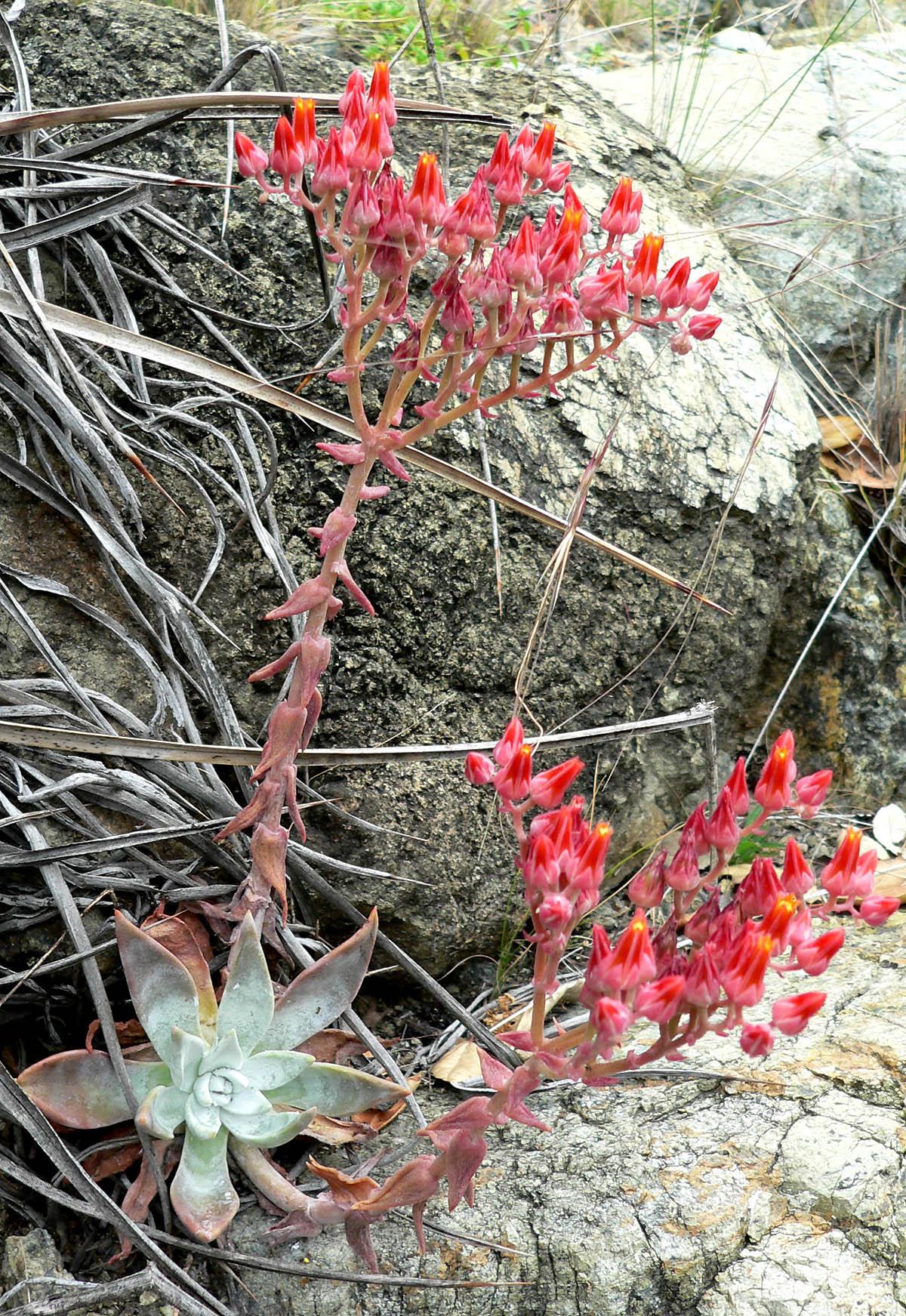
Dudleyas have their share of disease and pest problems. If you can prevent Argentine Ants from introducing mealybugs or aphids to your Dudleyas, they will be healthier.
Dudleya farinosa (Lindl.) Britton & Rose
Common Names
Bluff Lettuce, Powdery Liveforever, Powdery Dudleya, North Coast Dudleya, Sea Lettuce

Synonyms
Echeveria farinosa (basionym), Cotyledon compacta, Cotyledon eastwoodiae, Cotyledon farinosa, Cotyledon lingula, Cotyledon septentrionalis, Dudleya compacta, Dudleya eastwoodiae, Dudleya lingula, Dudleya septentrionalis, Echeveria compacta, Echeveria eastwoodiae, Echeveria farinosa, Echeveria lingula, Echeveria septentrionalis

Scientific Classification
Family: Crassulaceae
Subfamily: Sedoideae
Tribe: Sedeae
Subtribe: Sedinae
Genus: Dudleya

Description
Dudleya farinosa is a succulent plant, variable in appearance from drab to spectacular. It grows from a branching caudex and forms a basal rosette of wide, pointed, spade-shaped leaves, up to 2.4 inches (6 cm) across. The leaves are generally very pale green but they often have edges or tips of bright colors, particularly bright reds. The plant erects a tall stem which is pale green with pink or red tinting, atop which it bears a branching flower cluster with many pale to bright yellow flowers.

How to Grow and Care
Most of the myriad habitats Dudleyas occupy become dry in summer. Therefore, it is important to cut off water to Dudleyas in your garden during summer. Plants grown in sandy soils or containers are exceptions; they will accept infrequent summer watering as long as the soil drains well. The onset of fall or winter rains reawakens Dudleyas from drought-induced dormancy. Their shriveled leaves plump up quickly, growth resumes, and flowering occurs during the next spring or summer. Dudleyas are amazingly resilient; if a portion of a colony sloughs off a cliff face or is uprooted by a burrowing animal, it can persist for months until soil contact is reestablished. Species that naturally grow on ocean bluffs are also salt-spray tolerant.

Dudleyas have their share of disease and pest problems. If you can prevent Argentine Ants from introducing mealybugs or aphids to your Dudleyas, they will be healthier.
0
0
文章
Dummer. ゛☀
2017年10月02日

Scientific Name
Echeveria x imbricata Deleuil ex E. Morren
Common Names
Blue Rose Echeveria, Hens and Chicks
Synonyms
Echeveria ‘Imbricata’, Echeveria imbricata
Scientific Classification
Family: Crassulaceae
Subfamily: Sedoideae
Tribe: Sedeae
Subtribe: Sedinae
Genus: Echeveria
Description
Echeveria x imbricata is a popular and vigorous succulent, up to 8 inches (20 cm) wide, with tight rosettes of flat grey-green leaves that, when mature, form offsets freely to form large solid clumps up to 6 inches (15 cm) tall. Blue Rose Echeveria has a branched arching inflorescence bearing clusters of red and yellow flowers in the spring and early summer.
How to Grow and Care
Most of the common Echeveria species are not complicated succulents to grow, provided you follow a few basic rules. First, be careful never to let water sit in the rosette as it can cause rot or fungal diseases that will kill the plant. Additionally, remove dead leaves from the bottom of the plant as it grows. These dead leaves provide a haven for pests, and Echeveria are susceptible to mealy bugs. As with all succulents, careful watering habits and plenty of light will help ensure success.
Repot as needed, preferably during the warm season. To repot a succulent, make sure the soil is dry before repotting, then gently remove the pot. Knock away the old soil from the roots, making sure to remove any rotted or dead roots in the process. Treat any cuts with a fungicide.
Echeveria x imbricata Deleuil ex E. Morren
Common Names
Blue Rose Echeveria, Hens and Chicks

Synonyms
Echeveria ‘Imbricata’, Echeveria imbricata
Scientific Classification
Family: Crassulaceae
Subfamily: Sedoideae
Tribe: Sedeae
Subtribe: Sedinae
Genus: Echeveria

Description
Echeveria x imbricata is a popular and vigorous succulent, up to 8 inches (20 cm) wide, with tight rosettes of flat grey-green leaves that, when mature, form offsets freely to form large solid clumps up to 6 inches (15 cm) tall. Blue Rose Echeveria has a branched arching inflorescence bearing clusters of red and yellow flowers in the spring and early summer.

How to Grow and Care
Most of the common Echeveria species are not complicated succulents to grow, provided you follow a few basic rules. First, be careful never to let water sit in the rosette as it can cause rot or fungal diseases that will kill the plant. Additionally, remove dead leaves from the bottom of the plant as it grows. These dead leaves provide a haven for pests, and Echeveria are susceptible to mealy bugs. As with all succulents, careful watering habits and plenty of light will help ensure success.

Repot as needed, preferably during the warm season. To repot a succulent, make sure the soil is dry before repotting, then gently remove the pot. Knock away the old soil from the roots, making sure to remove any rotted or dead roots in the process. Treat any cuts with a fungicide.
10
6
文章
Dummer. ゛☀
2017年10月02日

Scientific Name
Echeveria secunda Booth ex Lindl.
Common Names
Old Hens and Chicks, Hens and Chicks, Blue Echeveria, Glaucous Echeveria
Synonyms
Cotyledon glauca (basionym), Echeveria glauca
Scientific Classification
Family: Crassulaceae
Subfamily: Sedoideae
Tribe: Sedeae
Subtribe: Sedinae
Genus: Echeveria
Description
Echeveria secunda is a succulent that forms attractive clumps up to 6 inches (15 cm) tall, tight rosettes of short blue-gray leaves and in late spring appear flowers on up to 1 foot (30 cm) tall arching stems. The flowers are fairly large compared to the plant and have red calyces and yellow petals, giving them a bi-colored appearance. A hint of pink on older leaves and leaf margins is evident, primarily in winter.
How to Grow and Care
Most of the common Echeveria species are not complicated succulents to grow, provided you follow a few basic rules. First, be careful never to let water sit in the rosette as it can cause rot or fungal diseases that will kill the plant. Additionally, remove dead leaves from the bottom of the plant as it grows. These dead leaves provide a haven for pests, and Echeveria are susceptible to mealy bugs. As with all succulents, careful watering habits and plenty of light will help ensure success.
Repot as needed, preferably during the warm season. To repot a succulent, make sure the soil is dry before repotting, then gently remove the pot. Knock away the old soil from the roots, making sure to remove any rotted or dead roots in the process. Treat any cuts with a fungicide. Place the plant in its new pot and backfill with potting soil, spreading the roots out as you repot.
Echeveria secunda Booth ex Lindl.
Common Names
Old Hens and Chicks, Hens and Chicks, Blue Echeveria, Glaucous Echeveria

Synonyms
Cotyledon glauca (basionym), Echeveria glauca
Scientific Classification
Family: Crassulaceae
Subfamily: Sedoideae
Tribe: Sedeae
Subtribe: Sedinae
Genus: Echeveria

Description
Echeveria secunda is a succulent that forms attractive clumps up to 6 inches (15 cm) tall, tight rosettes of short blue-gray leaves and in late spring appear flowers on up to 1 foot (30 cm) tall arching stems. The flowers are fairly large compared to the plant and have red calyces and yellow petals, giving them a bi-colored appearance. A hint of pink on older leaves and leaf margins is evident, primarily in winter.

How to Grow and Care
Most of the common Echeveria species are not complicated succulents to grow, provided you follow a few basic rules. First, be careful never to let water sit in the rosette as it can cause rot or fungal diseases that will kill the plant. Additionally, remove dead leaves from the bottom of the plant as it grows. These dead leaves provide a haven for pests, and Echeveria are susceptible to mealy bugs. As with all succulents, careful watering habits and plenty of light will help ensure success.

Repot as needed, preferably during the warm season. To repot a succulent, make sure the soil is dry before repotting, then gently remove the pot. Knock away the old soil from the roots, making sure to remove any rotted or dead roots in the process. Treat any cuts with a fungicide. Place the plant in its new pot and backfill with potting soil, spreading the roots out as you repot.
2
2
文章
Dummer. ゛☀
2017年10月02日

Scientific Name
Echeveria ‘Black Prince’
Common Names
Black Hens and Chicks
Scientific Classification
Family: Crassulaceae
Subfamily: Sedoideae
Tribe: Sedeae
Subtribe: Sedinae
Genus: Echeveria
Description
Echeveria ‘Black Prince’ is a slow and low growing succulent plant. It produces clumps of short rosettes up to 3 inches (7.5 cm) wide with thin dark triangular, blackish leaves. These leaves first emerge greenish but darken to a deep lavender brown and with age the lower leaves widen out to as much as 1 inch (2.5 cm) at the base with an acuminate tip that has fine yellow edges. The dark red flowers appear on short stalks in late fall to early winter.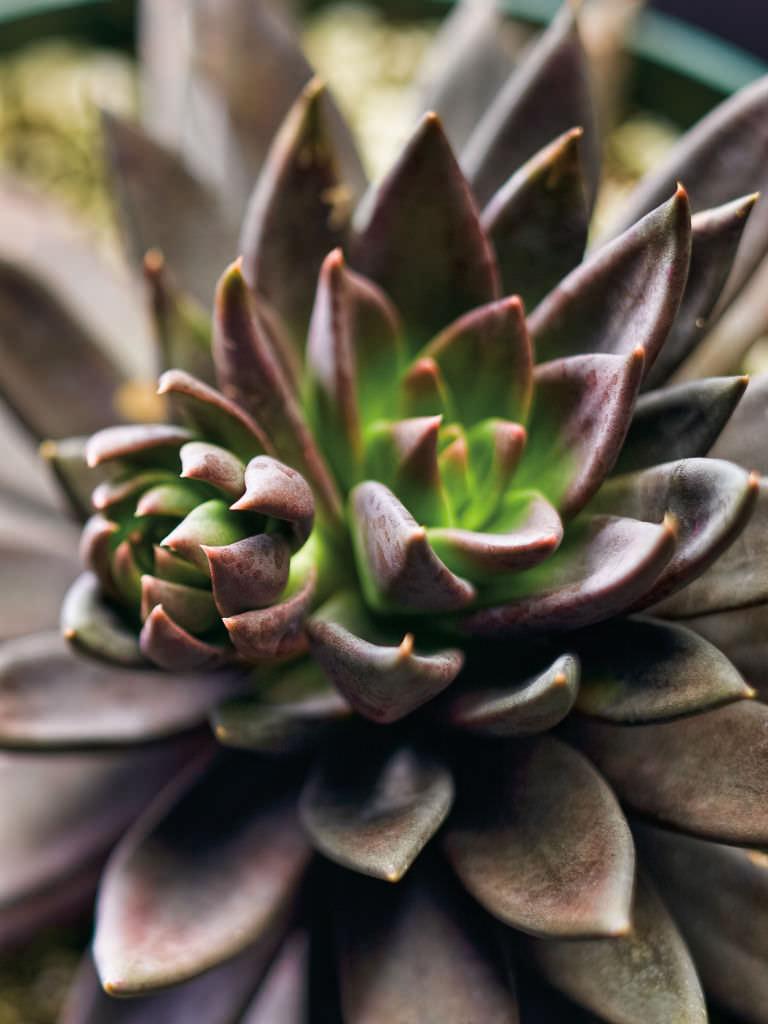
How to Grow and Care
Most of the common Echeveria species are not complicated succulents to grow, provided you follow a few basic rules. First, be careful never to let water sit in the rosette as it can cause rot or fungal diseases that will kill the plant. Additionally, remove dead leaves from the bottom of the plant as it grows. These dead leaves provide a haven for pests, and Echeveria are susceptible to mealy bugs. As with all succulents, careful watering habits and plenty of light will help ensure success.
Repot as needed, preferably during the warm season. To repot a succulent, make sure the soil is dry before repotting, then gently remove the pot. Knock away the old soil from the roots, making sure to remove any rotted or dead roots in the process. Treat any cuts with a fungicide. Place the plant in its new pot and backfill with potting soil, spreading the roots out as you repot.
Echeveria ‘Black Prince’
Common Names
Black Hens and Chicks
Scientific Classification
Family: Crassulaceae
Subfamily: Sedoideae
Tribe: Sedeae
Subtribe: Sedinae
Genus: Echeveria

Description
Echeveria ‘Black Prince’ is a slow and low growing succulent plant. It produces clumps of short rosettes up to 3 inches (7.5 cm) wide with thin dark triangular, blackish leaves. These leaves first emerge greenish but darken to a deep lavender brown and with age the lower leaves widen out to as much as 1 inch (2.5 cm) at the base with an acuminate tip that has fine yellow edges. The dark red flowers appear on short stalks in late fall to early winter.

How to Grow and Care
Most of the common Echeveria species are not complicated succulents to grow, provided you follow a few basic rules. First, be careful never to let water sit in the rosette as it can cause rot or fungal diseases that will kill the plant. Additionally, remove dead leaves from the bottom of the plant as it grows. These dead leaves provide a haven for pests, and Echeveria are susceptible to mealy bugs. As with all succulents, careful watering habits and plenty of light will help ensure success.

Repot as needed, preferably during the warm season. To repot a succulent, make sure the soil is dry before repotting, then gently remove the pot. Knock away the old soil from the roots, making sure to remove any rotted or dead roots in the process. Treat any cuts with a fungicide. Place the plant in its new pot and backfill with potting soil, spreading the roots out as you repot.
3
3
文章
Dummer. ゛☀
2017年10月02日

Scientific Name
Echeveria affinis E. Walther
Common Names
Black Echeveria
Scientific Classification
Family: Crassulaceae
Subfamily: Sedoideae
Tribe: Sedeae
Subtribe: Sedinae
Genus: Echeveria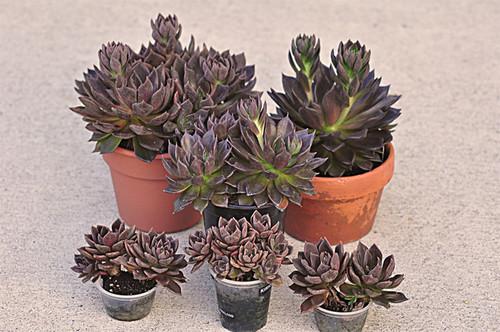
Description
Echeveria affinis is evergreen, low-growing, perennial succulent, up to 8 inches (20 cm) tall and wide. The levaes are fleshy, olive-brownish, up to 2 inches (5 cm) long and up to 0.8 inch (2 cm) wide, formed on rosettes. The red star-shaped flowers sprout on a stem during the summer.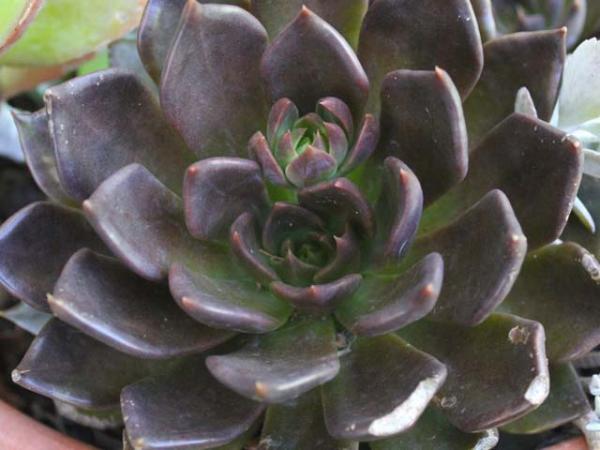
How to Grow and Care
Most of the common Echeveria species are not complicated succulents to grow, provided you follow a few basic rules. First, be careful never to let water sit in the rosette as it can cause rot or fungal diseases that will kill the plant. Additionally, remove dead leaves from the bottom of the plant as it grows. These dead leaves provide a haven for pests, and Echeveria are susceptible to mealy bugs. As with all succulents, careful watering habits and plenty of light will help ensure success.
Repot as needed, preferably during the warm season. To repot a succulent, make sure the soil is dry before repotting, then gently remove the pot. Knock away the old soil from the roots, making sure to remove any rotted or dead roots in the process. Treat any cuts with a fungicide.
Echeveria affinis E. Walther
Common Names
Black Echeveria
Scientific Classification
Family: Crassulaceae
Subfamily: Sedoideae
Tribe: Sedeae
Subtribe: Sedinae
Genus: Echeveria

Description
Echeveria affinis is evergreen, low-growing, perennial succulent, up to 8 inches (20 cm) tall and wide. The levaes are fleshy, olive-brownish, up to 2 inches (5 cm) long and up to 0.8 inch (2 cm) wide, formed on rosettes. The red star-shaped flowers sprout on a stem during the summer.

How to Grow and Care
Most of the common Echeveria species are not complicated succulents to grow, provided you follow a few basic rules. First, be careful never to let water sit in the rosette as it can cause rot or fungal diseases that will kill the plant. Additionally, remove dead leaves from the bottom of the plant as it grows. These dead leaves provide a haven for pests, and Echeveria are susceptible to mealy bugs. As with all succulents, careful watering habits and plenty of light will help ensure success.

Repot as needed, preferably during the warm season. To repot a succulent, make sure the soil is dry before repotting, then gently remove the pot. Knock away the old soil from the roots, making sure to remove any rotted or dead roots in the process. Treat any cuts with a fungicide.
8
6
ksc:wow. so beautiful
文章
Dummer. ゛☀
2017年10月01日

Scientific Name
Dudleya ingens Rose
Common Names
Baja Live Forever
Synonyms
Dudleya eximia, Dudleya viridicata, Echeveria ingens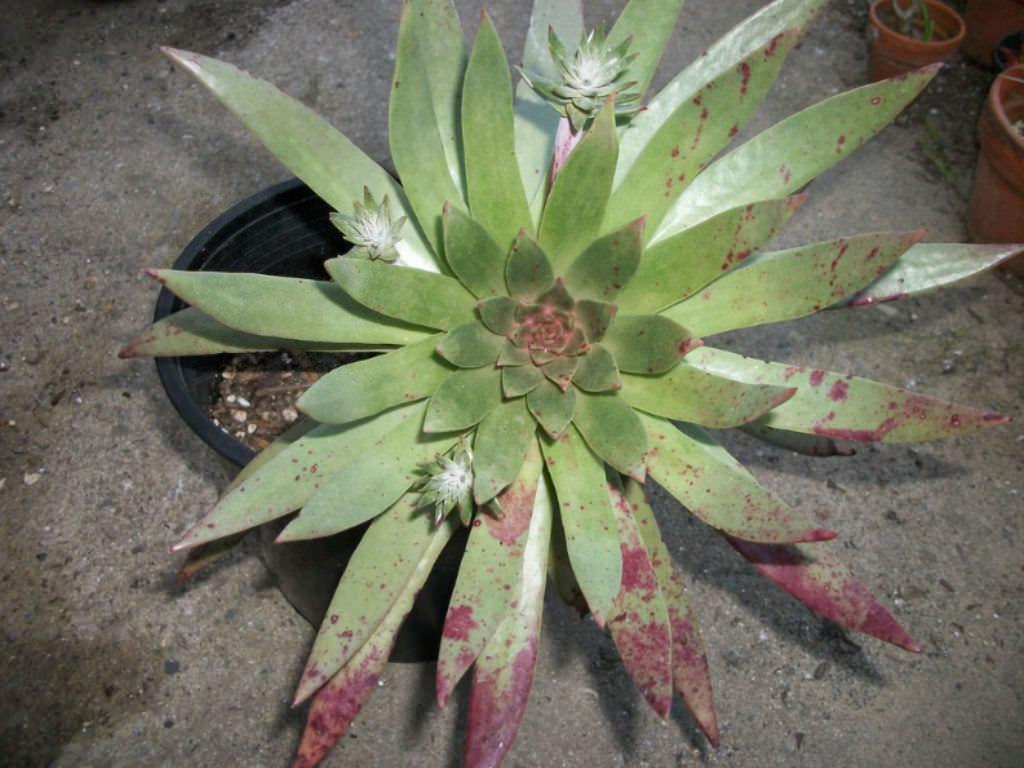
Scientific Classification
Family: Crassulaceae
Subfamily: Sedoideae
Tribe: Sedeae
Subtribe: Sedinae
Genus: Dudleya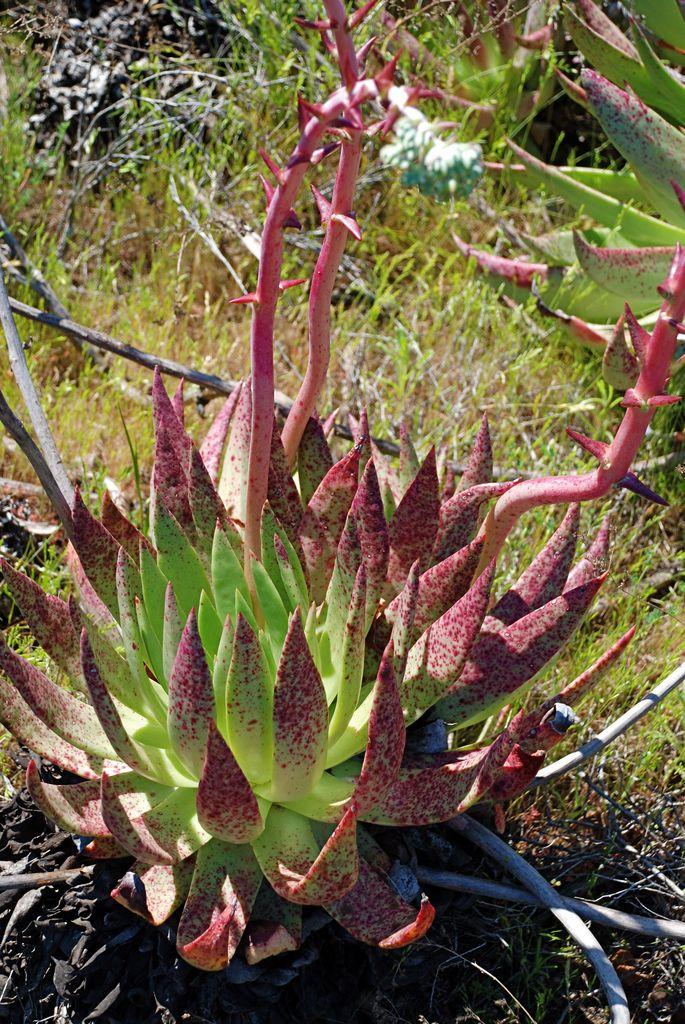
Description
Dudleya ingens is a rosette-forming succulent with usually solitary rosettes up to 10 inches (25 cm) wide, with many lance-shaped, green leaves with red spots that radiate out and slightly up. In spring to early summer appear the red stems bearing pale yellow blushed-pink flowers.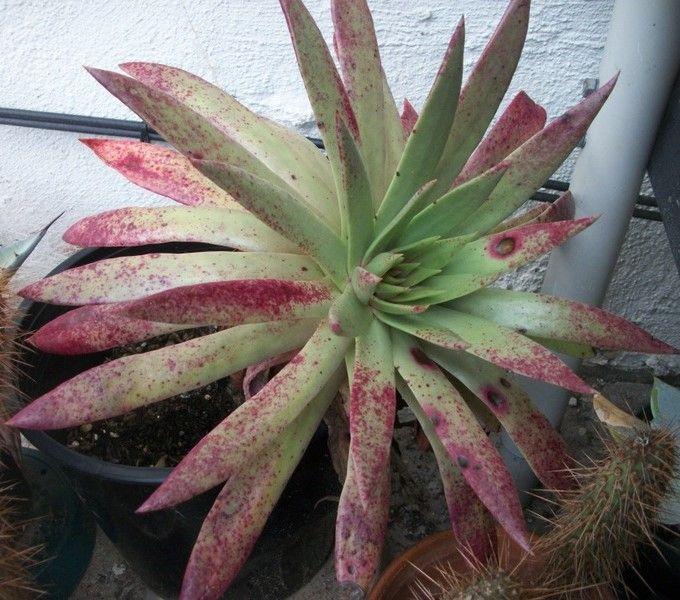
How to Grow and Care
Most of the myriad habitats Dudleyas occupy become dry in summer. Therefore, it is important to cut off water to Dudleyas in your garden during summer. Plants grown in sandy soils or containers are exceptions; they will accept infrequent summer watering as long as the soil drains well. The onset of fall or winter rains reawakens Dudleyas from drought-induced dormancy. Their shriveled leaves plump up quickly, growth resumes, and flowering occurs during the next spring or summer. Dudleyas are amazingly resilient; if a portion of a colony sloughs off a cliff face or is uprooted by a burrowing animal, it can persist for months until soil contact is reestablished. Species that naturally grow on ocean bluffs are also salt-spray tolerant.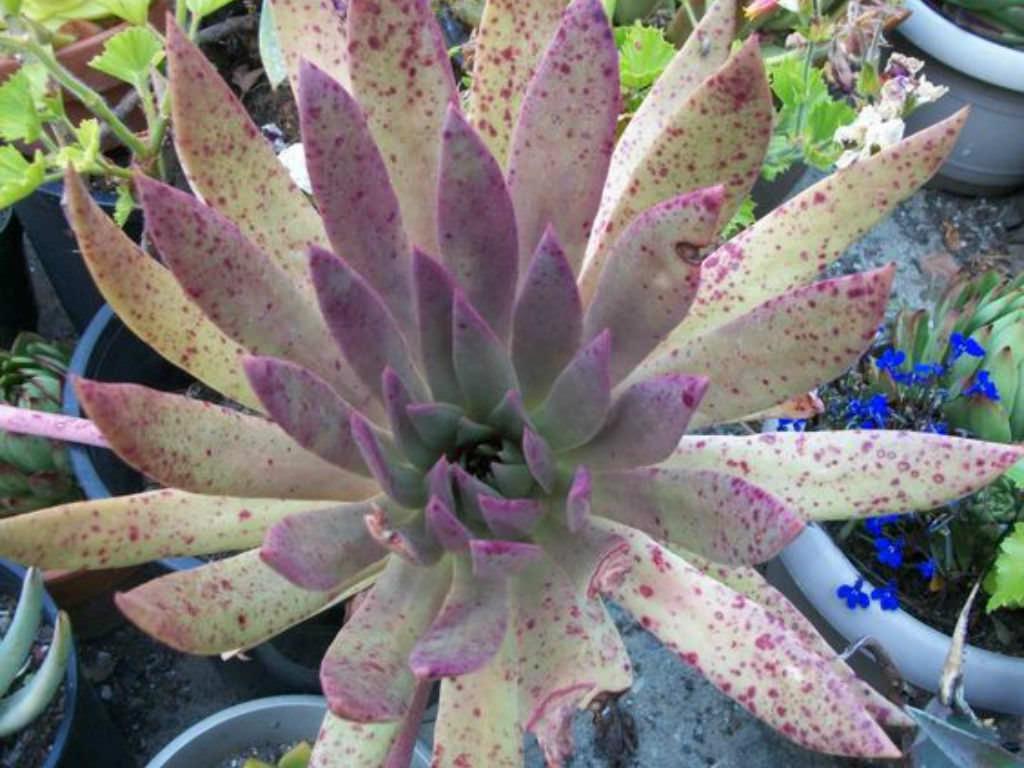
Dudleyas have their share of disease and pest problems. If you can prevent Argentine Ants from introducing mealybugs or aphids to your Dudleyas, they will be healthier.
Dudleya ingens Rose
Common Names
Baja Live Forever
Synonyms
Dudleya eximia, Dudleya viridicata, Echeveria ingens

Scientific Classification
Family: Crassulaceae
Subfamily: Sedoideae
Tribe: Sedeae
Subtribe: Sedinae
Genus: Dudleya

Description
Dudleya ingens is a rosette-forming succulent with usually solitary rosettes up to 10 inches (25 cm) wide, with many lance-shaped, green leaves with red spots that radiate out and slightly up. In spring to early summer appear the red stems bearing pale yellow blushed-pink flowers.

How to Grow and Care
Most of the myriad habitats Dudleyas occupy become dry in summer. Therefore, it is important to cut off water to Dudleyas in your garden during summer. Plants grown in sandy soils or containers are exceptions; they will accept infrequent summer watering as long as the soil drains well. The onset of fall or winter rains reawakens Dudleyas from drought-induced dormancy. Their shriveled leaves plump up quickly, growth resumes, and flowering occurs during the next spring or summer. Dudleyas are amazingly resilient; if a portion of a colony sloughs off a cliff face or is uprooted by a burrowing animal, it can persist for months until soil contact is reestablished. Species that naturally grow on ocean bluffs are also salt-spray tolerant.

Dudleyas have their share of disease and pest problems. If you can prevent Argentine Ants from introducing mealybugs or aphids to your Dudleyas, they will be healthier.
0
0
文章
Dummer. ゛☀
2017年10月01日

Scientific Name
Echeveria derenbergii J.A.Purpus
Common Names
Painted Lady, Baby Echeveria
Synonyms
Cotyledon pulvinata
Scientific Classification
Family: Crassulaceae
Subfamily: Sedoideae
Tribe: Sedeae
Subtribe: Sedinae
Genus: Echeveria
Description
Echeveria derenbergii is an evergreen perennial succulent, growing up to 4 inches (10 cm), with a small, dense basal rosette of pagoda-shaped, frosted, bristle-tipped, fleshy leaves. It blooms freely in summer with bell-shaped, bicolor, yellow flowers with “painted” red tips in winter.
How to Grow and Care
Most of the common Echeveria species are not complicated succulents to grow, provided you follow a few basic rules. First, be careful never to let water sit in the rosette as it can cause rot or fungal diseases that will kill the plant. Additionally, remove dead leaves from the bottom of the plant as it grows. These dead leaves provide a haven for pests, and Echeveria are susceptible to mealy bugs. As with all succulents, careful watering habits and plenty of light will help ensure success.
Repot as needed, preferably during the warm season. To repot a succulent, make sure the soil is dry before repotting, then gently remove the pot. Knock away the old soil from the roots, making sure to remove any rotted or dead roots in the process. Treat any cuts with a fungicide. Place the plant in its new pot and backfill with potting soil, spreading the roots out as you repot.
Echeveria derenbergii J.A.Purpus
Common Names
Painted Lady, Baby Echeveria

Synonyms
Cotyledon pulvinata
Scientific Classification
Family: Crassulaceae
Subfamily: Sedoideae
Tribe: Sedeae
Subtribe: Sedinae
Genus: Echeveria

Description
Echeveria derenbergii is an evergreen perennial succulent, growing up to 4 inches (10 cm), with a small, dense basal rosette of pagoda-shaped, frosted, bristle-tipped, fleshy leaves. It blooms freely in summer with bell-shaped, bicolor, yellow flowers with “painted” red tips in winter.

How to Grow and Care
Most of the common Echeveria species are not complicated succulents to grow, provided you follow a few basic rules. First, be careful never to let water sit in the rosette as it can cause rot or fungal diseases that will kill the plant. Additionally, remove dead leaves from the bottom of the plant as it grows. These dead leaves provide a haven for pests, and Echeveria are susceptible to mealy bugs. As with all succulents, careful watering habits and plenty of light will help ensure success.

Repot as needed, preferably during the warm season. To repot a succulent, make sure the soil is dry before repotting, then gently remove the pot. Knock away the old soil from the roots, making sure to remove any rotted or dead roots in the process. Treat any cuts with a fungicide. Place the plant in its new pot and backfill with potting soil, spreading the roots out as you repot.
0
1
文章
Dummer. ゛☀
2017年10月01日

Scientific Name
Echeveria pallida E.Walther
Common Names
Argentine Echeveria
Scientific Classification
Family: Crassulaceae
Subfamily: Sedoideae
Tribe: Sedeae
Subtribe: Sedinae
Genus: Echeveria
Description
Echeveria pallida is a fast growing succulent plant, up to 20 inches (50 cm) tall. Lax rosettes are up to 10 inches (25 cm) in diameter, on an unbranched stem, up to 1.2 inches (3 cm) in diameter. Leaves are spoon-shaped, lime-green to yellow, with edge lightly glaucous. Flowers are pink, on a up to 3 feet (90 cm) tall inflorescence. Blooms in winter.
How to Grow and Care
Most of the common Echeveria species are not complicated succulents to grow, provided you follow a few basic rules. First, be careful never to let water sit in the rosette as it can cause rot or fungal diseases that will kill the plant. Additionally, remove dead leaves from the bottom of the plant as it grows. These dead leaves provide a haven for pests, and Echeveria are susceptible to mealy bugs. As with all succulents, careful watering habits and plenty of light will help ensure success.
Repot as needed, preferably during the warm season. To repot a succulent, make sure the soil is dry before repotting, then gently remove the pot. Knock away the old soil from the roots, making sure to remove any rotted or dead roots in the process. Treat any cuts with a fungicide. Place the plant in its new pot and backfill with potting soil, spreading the roots out as you repot.
Echeveria pallida E.Walther

Common Names
Argentine Echeveria
Scientific Classification
Family: Crassulaceae
Subfamily: Sedoideae
Tribe: Sedeae
Subtribe: Sedinae
Genus: Echeveria

Description
Echeveria pallida is a fast growing succulent plant, up to 20 inches (50 cm) tall. Lax rosettes are up to 10 inches (25 cm) in diameter, on an unbranched stem, up to 1.2 inches (3 cm) in diameter. Leaves are spoon-shaped, lime-green to yellow, with edge lightly glaucous. Flowers are pink, on a up to 3 feet (90 cm) tall inflorescence. Blooms in winter.

How to Grow and Care
Most of the common Echeveria species are not complicated succulents to grow, provided you follow a few basic rules. First, be careful never to let water sit in the rosette as it can cause rot or fungal diseases that will kill the plant. Additionally, remove dead leaves from the bottom of the plant as it grows. These dead leaves provide a haven for pests, and Echeveria are susceptible to mealy bugs. As with all succulents, careful watering habits and plenty of light will help ensure success.

Repot as needed, preferably during the warm season. To repot a succulent, make sure the soil is dry before repotting, then gently remove the pot. Knock away the old soil from the roots, making sure to remove any rotted or dead roots in the process. Treat any cuts with a fungicide. Place the plant in its new pot and backfill with potting soil, spreading the roots out as you repot.
4
1
mehrdad Jahdi:very nice...




